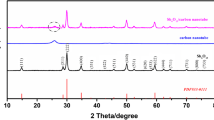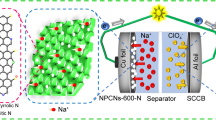Abstract
Carbon materials with high electronic conductivity and high surface area show obvious advantage as anode material for commercial sodium-ion batteries. Here, carbon nanotubes (CNTs) with porous and disordered structures (PCNTs) are synthesized via a facile K2CO3-assisted activation method. The open porous structures (specific surface areas of 444 m2 g−1) and abundant defects (O defects content of 7.2 at%) may not only shorten the transport path of Na ion, increase contact interface between electrolyte and electrode, but also facilitate the reversible capacity of Na storage. In addition, the 3D CNT conductive network improves the electronic conductivity. PCNT anode displays a favorable reversible capacity of 255 mAh g−1 after 200 cycles at 0.1 A g−1, with an initial Coulombic efficiency of 60% and excellent rate capability of 187 mAh g−1 at 2.00 A g−1. This work gives a simple strategy for manufacturing porous CNT anode for advanced energy storage devices.






Similar content being viewed by others
References
Pomerantseva E, Bonaccorso F, Feng XL, Cui Y, Gogotsi Y (2019) Energy storage: the future enabled by nanomaterials. Science 366(6468):eaan8285
Qi SH, Wu DX, Dong Y, Liao JQ, Foster CW, O’Dwyer C, Feng YZ, Liu CT, Ma JM (2019) Cobalt-based electrode materials for sodium-ion batteries. Chem Eng J 370:185–207
Li GZ, Huang B, Pan ZF, Su XY, Shao ZP, An L (2019) Advances in three-dimensional graphene-based materials: configurations, preparation and application in secondary metal (Li, Na, K, Mg, Al)-ion batteries. Energy Environ Sci 12(7):2030–2053
Wang QS, Mao BB, Stoliarov SI, Sun JH (2019) A review of lithium ion battery failure mechanisms and fire prevention strategies. Prog Energ Combust 73:95–131
Han WW, Zhou Y, Zhu T, Chu HQ (2020) Combustion synthesis of defect-rich carbon nanotubes as anodes for sodium-ion batteries. Appl Surf Sci 520:146317
Sun Y, Guo SH, Zhou HS (2019) Exploration of advanced electrode materials for rechargeable sodium-ion batteries. Adv Energy Mater 9(23):1800212
Li F, Wei ZX, Manthiram A, Feng YZ, Ma JM, Mai LQ (2019) Sodium-based batteries: from critical materials to battery systems. J Mater Chem A 7(16):9406–9431
Slater MD, Kim D, Lee E, Johnson CS (2013) Sodium-ion batteries. Adv Funct Mater 23(8):947–958
Yan YH, Xia SX, Sun H, Pang YP, Yang JH, Zheng SY (2020) A promising 3D crystalline red P/reduced graphene oxide aerogel architecture anode for sodium-ion batteries. Chem Eng J 393:124788
Tarascon JM, Armand M (2001) Issues and challenges facing rechargeable lithium batteries. Nature 414(6861):359–367
Jian ZL, Xing ZY, Bommier C, Li ZF, Ji XL (2016) Hard carbon microspheres: potassium-ion anode versus sodium-ion anode. Adv Energy Mater 6(3):1501874
Lu P, Sun Y, Xiang HF, Liang X, Yu Y (2018) 3D amorphous carbon with controlled porous and disordered structures as a high-rate anode material for sodium-ion batteries. Adv Energy Mater 8(8):1702434
Wang W, Zhou JH, Wang ZP, Zhao LY, Li PH, Yang Y, Yang C, Huang HX, Guo SJ (2018) Short-range order in mesoporous carbon boosts potassium-ion battery performance. Adv Energy Mater 8(5):1701648
Sun N, Guan ZRX, Liu YW, Cao YL, Zhu QZ, Liu H, Wang ZX, Zhang P, Xu B (2019) Extended “Adsorption-insertion” model: a new insight into the sodium storage mechanism of hard carbons. Adv Energy Mater 9(32):1901351
Stevens DA, Dahn JR (2000) High capacity anode materials for rechargeable sodium-ion batteries. J Electrochem Soc 147(4):1271–1273
Cao YL, Xiao LF, Sushko ML, Wang W, Schwenzer B, Xiao J, Nie ZM, Saraf LV, Yang ZG, Liu J (2012) Sodium ion insertion in hollow carbon nanowires for battery applications. Nano Lett 12(7):3783–3787
Kim YE, Yeom SJ, Lee JE, Kang SJ, Kang HS, Lee GH, Kim MJ, Lee SG, Lee HW, Chae HG (2020) Structure-dependent sodium ion storage mechanism of cellulose nanocrystal-based carbon anodes for highly efficient and stable batteries. J Power Sources 468:228371
Zhang Q, Huang JQ, Qian WZ, Zhang YY, Wei F (2013) The road for nanomaterials industry: a review of carbon nanotube production, post-treatment, and bulk applications for composites and energy storage. Small 9(8):1237–1265
Landi BJ, Ganter MJ, Cress CD, DiLeo RA, Raffaelle RP (2009) Carbon nanotubes for lithium ion batteries. Energy Environ Sci 2(6):638–654
Zhao J, Buldum A, Han J, Lu JP (2000) First-principles study of Li-intercalated carbon nanotube ropes. Phys Rev Lett 85(8):1706–1709
Fang RP, Chen K, Yin LC, Sun ZH, Li F, Cheng HM (2019) The regulating role of carbon nanotubes and graphene in lithium-ion and lithium-sulfur batteries. Adv Mater 31(9):1800863
Wang W, Kumta PN (2010) Nanostructured hybrid silicon/carbon nanotube heterostructures: reversible high-capacity lithium-ion anodes. ACS Nano 4(4):2233–2241
Hao J, Pan L, Zhang HC, Chi CX, Guo QJ, Zhao JP, Yang Y, Liu XX, Ma XX, Li Y (2018) A general method for high-performance Li-ion battery Ge composites electrodes from ionic liquid electrodeposition without binders or conductive agents: the cases of CNTs, RGO and PEDOT. Chem Eng J 346:427–437
Chen YY, Hu XD, Evanko B, Sun XH, Li X, Hou TY, Cai S, Zheng CM, Hu WB, Stucky GD (2018) High-rate FeS2/CNT neural network nanostructure composite anodes for stable, high-capacity sodium-ion batteries. Nano Energy 46:117–127
Yao ZJ, Xia XH, Zhou CA, Zhong Y, Wang YD, Deng SJ, Wang WQ, Wang XL, Tu JP (2018) Smart construction of integrated CNTs/Li4Ti5O12 core/shell arrays with superior high-rate performance for application in lithium-ion batteries. Adv Sci 5(3):1700786
Li Z, Cao LJ, Chen W, Huang ZC, Liu H (2019) Mesh-like carbon nanosheets with high-level nitrogen doping for high-energy dual-carbon lithium-ion capacitors. Small 15(15):1805173
Jian ZL, Hwang S, Li ZF, Hernandez AS, Wang XF, Xing ZY, Su D, Ji XL (2017) Hard-soft composite carbon as a long-cycling and high-rate anode for potassium-ion batteries. Adv Funct Mater 27(26):1700324
Chen P, Fan Y, Gao YT, Liu Q, Sun YH, Guo T, Huang BL, Wang X, Fu YS (2020) Design and construction of graphitic/amorphous heterophase porous carbon with a lotus-leaf-like surface microstructure for high-performance Li-ion and Na-ion batteries. Ind Eng Chem Res 59(25):11475–11484
Mubarak N, Ihsan-Ul-Haq M, Huang H, Cui J, Yao SS, Susca A, Wu JX, Wang MY, Zhang XH, Huang BL, Kim JK (2020) Metal-organic framework-induced mesoporous carbon nanofibers as an ultrastable Na metal anode host. J Mater Chem A 8(20):10269–10282
Zou KX, Guan ZX, Deng YF, Chen GH (2020) Nitrogen-rich porous carbon in ultra-high yield derived from activation of biomass waste by a novel eutectic salt for high performance Li-ion capacitors. Carbon 161:25–35
Wang HW, Xu DM, Jia GC, Mao ZF, Gong YS, He BB, Wang R, Fan HJ (2020) Integration of flexibility, cyclability and high-capacity into one electrode for sodium-ion hybrid capacitors with low self-discharge rate. Energy Storage Mater 25:114–123
Xia JL, Yan D, Guo LP, Dong XL, Li WC, Lu AH (2020) Hard carbon nanosheets with uniform ultramicropores and accessible functional groups showing high realistic capacity and superior rate performance for sodium-ion storage. Adv Mater 32(21):2000447
Sun D, Luo B, Wang HY, Tang YG, Ji XB, Wang LZ (2019) Engineering the trap effect of residual oxygen atoms and defects in hard carbon anode towards high initial Coulombic efficiency. Nano Energy 64:103937
Zhong SY, Liu HZ, Wei DH, Hu J, Zhang H, Hou HS, Peng MX, Zhang GH, Duan HG (2020) Long-aspect-ratio N-rich carbon nanotubes as anode material for sodium and lithium ion batteries. Chem Eng J 395:125054
Hou HS, Banks CE, Jing MJ, Zhang Y, Ji XB (2015) Carbon quantum dots and their derivative 3D porous carbon frameworks for sodium-ion batteries with ultralong cycle life. Adv Mater 27(47):7861–7866
Zheng WG, Wu M, Yang C, Tang ZG, Hu HN (2020) Carbon nanotube linked NaTi2(PO4)3/C composite with three-dimensional conductive network as superior electrode for sodium ion battery. Ionics 26(6):2883–2890
Zhu SM, Dong XF, Huang H, Qi M (2020) High capacitive sodium-ion storage in N, P co-doped carbon supported on carbon nanotubes. J Electroanal Chem 870:114200
Feng WT, Cui YP, Liu W, Wang HL, Zhang Y, Du YX, Liu S, Wang HL, Gao X, Wang TQ (2020) Rigid-flexible coupling carbon skeleton and potassium-carbonate-dominated solid electrolyte interface achieving superior potassium-ion storage. ACS Nano 14(4):4938–4949
Wang XH, Qi L, Wang HY (2020) Carbon nano-beads collected from candle soot as an anode material with a highly pseudocapacitive Na+ storage capability for dual-ion batteries. Ionics. 26:4533–4542. https://doi.org/10.1007/s11581-020-03630-5
Hong WW, Zhang Y, Yang L, Tian Y, Ge P, Hu JG, Wei WF, Zou GQ, Hou HS, Ji XB (2019) Carbon quantum dot micelles tailored hollow carbon anode for fast potassium and sodium storage. Nano Energy 65:104038
Acknowledgments
The authors thank the Natural Science Foundation of Ningxia Province (No. 2018AAC03022), the Key Research and Development Program of Ningxia Province of China (No. 2018BEE03012), the National First-rate Discipline Construction Project of Ningxia (Chemical Engineering & Technology, NXYLXK2017A04), and the Heilongjiang Provincial Natural Science Foundation of China (No. LH2020B016).
Author information
Authors and Affiliations
Corresponding author
Ethics declarations
Conflict of interest
The authors declare that they have no conflict of interest.
Additional information
Publisher’s note
Springer Nature remains neutral with regard to jurisdictional claims in published maps and institutional affiliations.
Supplementary Information
ESM 1
(DOCX 5079 kb)
Rights and permissions
About this article
Cite this article
Hao, J., Xu, L., Bai, J. et al. Porous structure O-rich carbon nanotubes as anode material for sodium-ion batteries. Ionics 27, 667–675 (2021). https://doi.org/10.1007/s11581-020-03882-1
Received:
Accepted:
Published:
Issue Date:
DOI: https://doi.org/10.1007/s11581-020-03882-1




